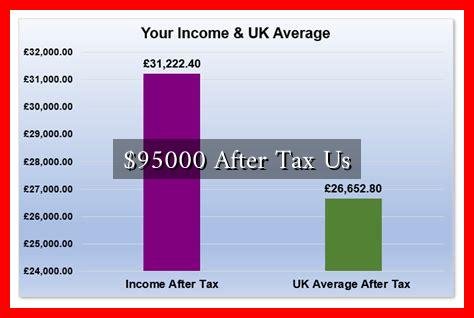-
Table of Contents
$95,000 After Tax in the U.S.: Understanding Your Take-Home Pay
In the United States, understanding your take-home pay after taxes is crucial for effective financial planning. Earning $95,000 annually is a significant income, but how much of that actually ends up in your pocket? This article will explore the implications of earning $95,000 after tax, including tax brackets, deductions, and how to maximize your take-home pay.
Understanding Tax Brackets
The U.S. tax system is progressive, meaning that as your income increases, so does the rate at which you are taxed. For the 2023 tax year, the federal income tax brackets are as follows:
- 10% on income up to $11,000
- 12% on income over $11,000 and up to $44,725
- 22% on income over $44,725 and up to $95,375
- 24% on income over $95,375 and up to $182,100
For someone earning $95,000, the effective tax rate will be lower than the highest bracket they fall into. This is because only the income above each threshold is taxed at the higher rates.
. Therefore, understanding how these brackets work is essential for calculating your after-tax income.
Calculating Federal Taxes
To estimate the federal taxes owed on a $95,000 income, we can break it down as follows:
- 10% on the first $11,000: $1,100
- 12% on the next $33,725 ($44,725 – $11,000): $4,047
- 22% on the next $50,275 ($95,000 – $44,725): $11,061
Adding these amounts gives a total federal tax liability of approximately $16,208. This results in an effective tax rate of about 17% on the total income.
State Taxes and Other Deductions
In addition to federal taxes, state taxes can significantly impact your take-home pay. Each state has its own tax rates and brackets. For example:
- California: Up to 13.3% for high earners
- Texas: No state income tax
- New York: Up to 10.9% for high earners
Assuming an average state tax rate of 5%, an additional $4,750 would be deducted from your income. Furthermore, other deductions such as Social Security (6.2% up to $160,200) and Medicare (1.45%) also apply. This could add another $7,240 to your tax burden.
Maximizing Your Take-Home Pay
To maximize your take-home pay, consider the following strategies:
- Contribute to Retirement Accounts: Contributions to 401(k) or IRA accounts can reduce your taxable income.
- Utilize Tax Deductions: Itemizing deductions for mortgage interest, student loans, or medical expenses can lower your taxable income.
- Consider Tax Credits: Tax credits directly reduce your tax liability and can significantly impact your overall tax bill.
For more detailed information on tax strategies, you can visit the IRS website at www.irs.gov.
Conclusion
Understanding your take-home pay after taxes is essential for effective financial planning. Earning $95,000 annually can provide a comfortable lifestyle, but it’s crucial to account for federal and state taxes, as well as other deductions. By leveraging tax strategies and understanding the tax brackets, you can maximize your take-home pay and make informed financial decisions. Remember, the key to financial success lies not just in how much you earn, but in how much you keep.





